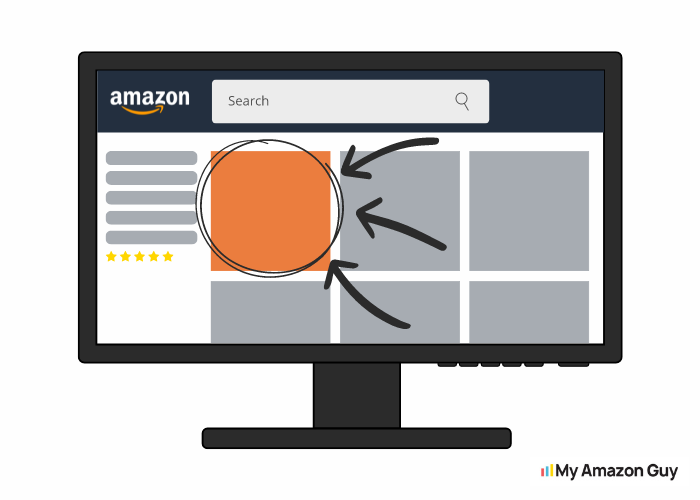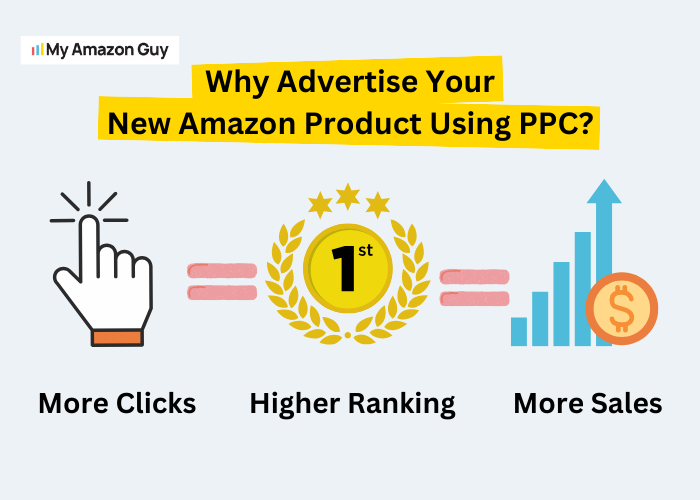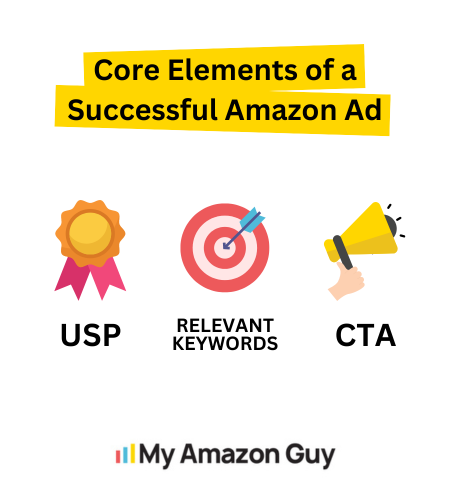Last Updated: August 22, 2025
Don’t waste your ad spend! Master the ultimate Amazon PPC guide for 2025 and start driving real results for your products.
Got a brand new product that deserves attention? You launched it, it’s live on Amazon, but… crickets.
That’s where Amazon PPC campaigns come in. It lets you put your product in front of the right customers at exactly the right time.
This blog post discusses how Amazon sellers can run profitable PPC campaigns in 2025 by understanding ad types, avoiding common mistakes, and applying proven strategies. By the end of it, you will know how to set up ads that increase visibility, drive more sales, and protect your margins.
Table of Contents
Smarter Amazon Marketing Starts Here
From keyword research to campaign management, our team knows how to deliver results. Take your advertising campaigns to the next level.
Understanding the Amazon PPC Campaign
Even if you list your product live on Amazon, if nobody sees it, it won’t sell. Amazon PPC (Pay-Per-Click) campaigns are your secret weapon to get noticed by the right customers.
Amazon PPC is a type of advertising designed specifically for Amazon sellers. It works by showing sponsored ads for your products when shoppers search for related items.
The best part? You only pay when someone clicks on your ad, not just for impressions. This makes PPC a cost-effective way to stand out in a crowded marketplace and attract buyers genuinely interested in your product.
The Different Types of Amazon PPC Campaigns
There are three main types of Amazon PPC campaigns that sellers can use when advertising on Amazon. Each campaign type serves a different purpose, depending on your goals and the audience you want to reach.
1. Sponsored Products Ads
Sponsored Products are the classic Amazon ads that act like mini billboards for your product. They appear on search results pages and product detail pages, showing your product image, headline, and price to shoppers actively searching for similar items.
These ads are perfect for boosting visibility and driving direct sales. In fact, 74% of third-party sellers choose Sponsored Product Ads, making them the most popular ad type on Amazon.
2. Sponsored Brands Ads
Sponsored Brands Ads highlight your brand with a logo, custom headline, and multiple product listings. They are ideal for improving brand awareness and showcasing a variety of products to shoppers in one view.
This format helps sellers reach a broader audience while reinforcing brand identity. It’s particularly useful for brands looking to promote multiple products at once and build recognition.
3. Sponsored Display Ads
Sponsored Display Ads extend your reach beyond Amazon by appearing on relevant websites and apps visited by potential customers. These visually engaging ads keep your brand top-of-mind even when shoppers are browsing outside the platform.
They are effective for retargeting past shoppers or introducing your products to new audiences. Using Sponsored Display Ads ensures your products stay visible to buyers throughout their online journey.
Why Advertise Your New Amazon Product Using a PPC Campaign?
It can be difficult to stand out in such a crowded marketplace as Amazon, especially with over 600 million products listed. PPC campaigns give your new product a chance to be seen by the right shoppers at the right time.
- Put your product at the top of Amazon search results.
- Reach shoppers actively searching for products like yours.
- Drive more clicks to your product listing.
- Increase sales by targeting ready-to-buy customers.
- Improve organic ranking through higher engagement.
- Collect data to optimize campaigns and keywords.
- Build brand awareness among potential customers.
- Stand out from competitors in your product category.
The Complete Step-by-Step Guide to Crush Your Amazon PPC Campaign
Using Amazon PPC campaigns can get expensive if you don’t know how to use them effectively, leading to wasted ad spend without real sales. With the right guide, managing Amazon PPC becomes simple and easier, helping you drive clicks, conversions, and measurable results.
Step 1: Keyword Research is King
When you’re searching for something on Amazon, do you think about how many other people are looking for that same thing every month? That’s called search volume, and it’s an important factor to consider when creating your PPC campaigns.
Finding the right keywords is the first step to building effective ads. So, use tools like Jungle Scout, analyze competitors’ advertising strategies, focus on relevant keywords with high search volume, and target Amazon keywords with low competition to get your ads seen by the right audience.
Step 2: Choose the Right Campaign Structure
Choosing the right campaign structure is key to running an effective PPC campaign. There are two main campaign types you can choose from, and both have their benefits and drawbacks, so pick the one that best suits your goals.
Automatic Campaigns
Automatic campaigns are a type of Amazon PPC campaign where Amazon chooses which keywords and products to target for you. They’re designed to make ad setup simple, letting you get started quickly without detailed keyword research.
Pros of Using Automatic Campaigns
- Perfect for beginners, no need for in-depth keyword research or bidding strategies.
- Get your PPC campaigns running fast without extensive setup time.
- May discover relevant keywords you might have missed.
Cons of Using Automatic Campaigns
- Limited control over targeting and bidding can lead to wasted ad spend on irrelevant searches.
- May target irrelevant keywords or bid too high, impacting your advertising costs.
- Difficult to fine-tune campaigns for optimal performance.
Manual Campaigns
Manual campaigns give you full control over which keywords and products your ads target. They allow you to set specific bids and use advanced strategies to optimize performance.
Pros of Using Manual Campaigns
- Control who sees your ads by choosing specific keywords and targeting options.
- Set bids for individual keywords to maximize return on ad spend (ROAS).
- Allows for A/B testing and other advanced optimization techniques.
Cons of Using Manual Campaigns
- Requires research and understanding of bidding strategies, keyword research, and campaign management.
- Takes more time and effort to set up and manage compared to automatic campaigns.
- Manual bidding requires monitoring to avoid overspending or underbidding.
Step 3: Create Effective Amazon Ads
There are three core elements that sellers should focus on if they want to create a successful Amazon PPC ad which are a Unique Selling Proposition (USP), relevant keywords, and a clear call to action (CTA). Combine these elements and you can craft ads that grab attention, reach the right audience, and turn clicks into sales.
Setting Up an Amazon Ad: A Quick Guide
Setting up an Amazon PPC ad properly is key to getting the best results from your campaigns. Follow these steps to launch, target, and optimize your ads effectively.
- Pick Your Ad Type
Choose between Sponsored Products, which appear next to search results, or Sponsored Brands, which are more prominent with video or headline placements. Pick the type that aligns with your goals, whether it’s boosting visibility or highlighting your brand. - Set Budget
Decide on a daily budget that fits your business size and goals. Start small, like $20 for new products, and increase as you see results and gain confidence. - Create Your Winning Campaign
Give your campaign a clear name that includes the product and targeting details. Select the products to advertise using their SKUs to ensure accurate tracking and reporting. - Targeting Options
Choose between Automatic targeting for simplicity or Manual targeting for more control. Automatic helps you discover keywords, while Manual lets you pick specific keywords, products, or categories to target. - Monitor & Optimize
Regularly check your campaigns to see how they perform. Adjust bids, keywords, and targeting to maximize clicks, conversions, and ROI over time.
Step 4: Bidding Strategies for the Win
Bidding on Amazon PPC ads is like setting the maximum amount you’re willing to pay for a click, similar to an auction, but for ad traffic. You can choose Automatic Bidding for a simple, time-saving approach, or Manual Bidding if you want full control over your budget, keywords, and optimization goals.
Automatic Bidding
Automatic Bidding lets Amazon set your bids for each click based on your campaign goals, making it easy to get started without managing individual bids. It’s ideal for new sellers or those who want a hands-off approach while still driving traffic to their products.
Pros of Using Automatic Bidding
- You don’t need to spend time researching and setting individual bids.
- Amazon’s system automatically manages your bids for you.
Cons of Using Automatic Bidding
- You have less control over how much you’re spending on each click.
- Automatic bidding might target irrelevant searches or bid too high.
Manual Bidding
Manual Bidding lets you set the exact amount you’re willing to pay for each click, giving you full control over your ad spend. It’s best for experienced sellers who want to target specific keywords and optimize their campaigns for maximum return.
Pros of Using Manual Bidding
- You decide the maximum amount you’re willing to pay for each click.
- You can avoid unnecessary clicks by setting lower bids.
Cons of Using Manual Bidding
- You need to monitor your bids and adjust them regularly.
- If you’re not careful, you could end up paying too much per click.
Tip: Start with Automatic Bidding, then switch to Manual Bidding for more control as you learn.
Step 5: Launch, Monitor, and Optimize Like a MAGnificent Pro!
Launching your Amazon PPC campaign is just the beginning because you need to actively monitor and optimize to get the best results. Regularly check performance, increase bids for keywords with high ROAS, and lower bids or block irrelevant keywords that have low sales or high ACoS.
Keep an eye on search terms and placements to maximize your campaign’s effectiveness. Identify profitable search terms to target in new campaigns, remove irrelevant keywords as negatives, and adjust bids for high- and low-performing ad placements to improve overall performance.
Maximize Your Campaign Performance
Stop wasting ad spend on ineffective targeting. Our experts can fine-tune your advertising campaigns for better ROI.
Common Amazon PPC Mistakes Sellers Should Avoid
Ever feel like your Amazon pay-per-click campaigns aren’t delivering the results you expected? You might be making common mistakes that drain your budget without generating meaningful sales.
1. Setting Up and Walking Away
Just setting up your Amazon PPC campaigns and walking away won’t get the results you want. Ads need regular monitoring to ensure they are performing effectively and reaching the right audience.
Check in frequently to see which keywords, bids, and placements are delivering results. Make adjustments as needed to improve performance, prevent wasted spend, and maximize ROI.
2. Trying to Do Everything at Once
Many sellers make the mistake of launching multiple PPC ads at the same time, which makes it hard to see which ones are actually driving conversions. Focusing on too many ad types at once can waste budget and dilute your results.
Start with the core: Sponsored Products Ads, which put your product in front of shoppers actively searching for relevant items. Once you master these, gradually explore Sponsored Brands Ads for brand awareness and Sponsored Display Ads to reach a wider audience.
3. Keyword Mismanagement
Keywords are the foundation of any Amazon PPC campaign, so choosing the wrong ones can hurt your results. Many sellers get tempted by high-volume generic keywords, which are highly competitive and may not convert well for their specific products.
Instead, focus on niche keywords that accurately describe your product, even if they have lower search volume. Targeting the right audience, even a smaller one, can lead to higher conversions and a better return on ad spend.
Actionable Amazon PPC Strategies That Work
Getting the right PPC strategy can help sellers make the most out of their campaigns without going in blind. Focusing on proven tactics ensures your ad spend drives clicks, conversions, and measurable results.
1. Retarget Ads
Retargeting ads help you reach shoppers who have previously viewed or purchased related products, reminding them of your offer. This keeps your product top-of-mind and increases the chances of converting interested prospects into buyers.
By targeting past visitors, you can focus ad spend on people already familiar with your product category. Retarget ads are especially effective for boosting conversion rates without wasting budget on completely new audiences.
2. Set a Daily Budget
Proper financial management is essential to avoid overspending and maximize growth. Start by setting a conservative daily budget for new campaigns to test performance without risking too much ad spend.
Use Total Advertising Cost of Sale to measure overall efficiency, considering both organic and paid sales. A TACoS of 8-12% is generally ideal, ensuring steady growth while avoiding overly aggressive spending.
3. Use Video Ads
Video ads are one of the most effective tools Amazon sellers can use to boost conversions. Sponsored Brand video ads grab attention quickly, and with 93% of marketers reporting that videos are a crucial part of their marketing strategy, it’s clear why this format delivers such strong results.
The good news is that you don’t need a Hollywood-level production to make an impact. Even a simple 30-second video shot on your phone can be enough to highlight your product and drive higher engagement and sales.
FAQs About Amazon PPC Campaigns
Can I create Amazon PPC campaigns by myself?
Yes. You can set up an advertising campaign in Seller Central without needing an agency. However, it’s often better to work with an Amazon agency if you’re scaling quickly, managing multiple products, or struggling to keep ad costs under control.
How much should I spend on Amazon PPC per month?
It depends on your budget and goals, but most sellers have an average ACoS of 20-36%. Start small, test what works for your product on Amazon, and scale once you see consistent returns.
Should I focus on Amazon SEO or PPC?
Both matter. Amazon SEO builds long-term visibility, while PPC gives faster traffic and sales. For the best Amazon marketing strategy, use both together to boost ranking and conversions.
Don't Just Launch, Dominate: Mastering Amazon PPC Strategies
Amazon PPC campaigns are one of the most effective ways to boost visibility and sales on the platform. This guide walked you through the essentials of campaign setup, targeting options, bidding strategies, and performance tracking.
We also covered common mistakes sellers make, along with optimization tips to maximize ROI. Whether you’re a beginner or already running ads, applying these strategies can help you spend smarter and drive better results.
Want to make the most out of your Amazon PPC campaigns? Reach out to our full-service Amazon agency and let our experts help you create tailored strategies that increase sales and scale your brand.
Grow Your Product on Amazon
Get more visibility and sales with strategic Amazon PPC campaigns. We’ll help you scale your brand faster.







